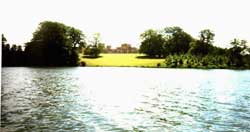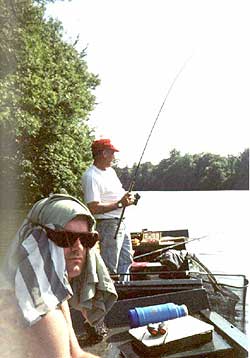| It is 5am on a lovely July morning, the car is loaded and the wind-ups have already started. I am 46 years old and Warren is I believe 29, but we are both acting like a pair of young kids. It’s always the same when we visit Blenheim Palace. The Palace is in rural Oxfordshire in the village of Woodstock, a beautiful part of the country and the drive there is a delight in itself and will take us only 50 minutes. We make this trip four or five times a year and I have been doing that for about 25 years, yet the anticipation is still high and the rivalry between the two of us is as keen as ever. Bets are placed, we bet pints on the biggest tench and bream, the most species caught and the highest overall weight. All bets have to be honoured that same evening so the day is rounded off by a visit to the pub – what a life eh.
Nice to get a bend in the rod It’ll be nice to get a bend in the rod at last, since the start of this season we have been trying to catch some large bream from a 240 acre inland sea which is proving to be very difficult. By that I mean we haven’t caught anything. Warren has managed to scoop out a fish of 17lb 2oz with his bare hands while drifting around in the boat one hot sunny day though, but that doesn’t count, does it? The journey seems to take no time at all and at 6am the car creeps quietly into the courtyard and we join the queue and wait for the palace gates to open. The fishing at Blenheim is from wooden punts. Each punt takes two anglers comfortably and there are 13 of them. The gateman arrives and huge wooden doors swing open to reveal the palace grounds. It always takes my breath away; 5000 acres of estate with beautiful gardens and a large ornamental lake, and not forgetting the house itself, which is huge. This was the birthplace of Sir Winston Churchill and is the ancestral home to the Duke of Marlborough. The palace gardens and lake were designed by Capability Brown and are open to the public. Once through the gates you drive towards the house, weaving the car around the many sheep which sleep on the tarmac road. As is always the case there is a mad rush by most to get to the boathouse and claim their swim. It’s like the start to the Indy 500 where the drivers have to run to their cars. We are not part of the rush, ours is the only car that that takes a different route. Fish-spotting from the bridge The lake is quite large, around 80 acres, and is split in two by a huge ornamental bridge, and it is to the bridge that we drove. From this vantage point you are about 30 feet above the water and it is perfect for spotting fish. The lake was looking magnificent, parts of it were still shrouded in mist and with the use of binoculars it was not long before we found what we wanted, a large area of water which was clouded up by the fish rooting around in the silt. At the boathouse there was just the one punt left, the other 12 now dotted around the water but nobody near where we had seen the fish – perfect. To get the most out of fishing from a punt it is important to be comfortable and organised. We had learnt from our numerous previous visits that it is best to string up the rods whilst still on the bank and to get the gear sorted tidily away in the punt before rowing out. As usual Warren does the fish-spotting while Murray does the work! Once everything had been carefully arranged and the rods set it was just a little matter of rowing a four hundredweight wooden box down the lake towards the bridge. This exercise could be made easier if both were rowing, but as usual I found myself in charge of the oars. Warren had convinced me once again that it would be best if he watched the water for signs of fish, (I assure you I am observing the water while sitting back drinking my tea watching Murray sweat) which seems to happen every time. The fish were there in numbers it seemed as a large area was clouded up, small pockets of bubbles fizzing the calm surface and every now and then a green back would break the surface. This to me is what it’s all about, brilliant surroundings, good company and the sort of fishing that some people never get to experience. We were chewing at the bit to get amongst them.
Tackle And Bait We fish identical rigs Warren and I, nothing fancy, just well-balanced gear. The rods are soft actioned 12ft wagglers made by Drennan. Line is 6Ib maxima straight through to a 12 or 14 Super Specialist hook. The wagglers are made by Drennan and are called ‘Gravel Pit Antennas’. These have a shotting capacity of 2 1/2 SSG. All the bulk shot is placed at the base of the float and is enough to sink the main body to the start of the antenna, then two number 6 shot are placed 4 inches above the hook. The number 6 shot sink the antenna down to the bulbous tip. The rig is set to fish 3 inches over depth and bites are normally shown by the float lifting right up in the water, unmissable. There is a strict no groundbait rule on Blenheim, which everybody seems to ignore, and we normally have a couple of bags of fishmeal knocked up just in case. Casters, corn and worms are the normal offerings but today I had brought along my new creation, my secret bait – Jelly Pelly. I’ve since seen a write-up on this bait but at the time it was something that I had been playing with for a while and as far as I knew nobody else was using it. Jelly Pelly came about as a result of my total inability to get expander pellets to sink without having to turn them into a mush. I reasoned that if they take in water so readily then they would also take in a liquid jelly mix, and if they did they would probably sink. After much playing around I settled on Rowntree’s Strawberry jelly cubes, these are dissolved in boiling water and a pint of this treats two pints of pellets. Once the pellets have soaked up the liquid and the jelly sets you get a nice soft pellet, which sinks well and leaks off loads of flavour. Would they work though? Warren thought I had lost my marbles but I was convinced these would slaughter them. Back to the Fishing Everything set, we plumbed the depth, which was around 5ft, set the rigs slightly overdepth and cast out. Warren fed casters and fished corn on the hook, I fed pellets and fished pellet on the hook. Well that’s not exactly accurate, I would have fed pellets, only before I could load the catapult, my float had risen 6 inches out of the water and was waving at me. The bait hadn’t been in the water for more than 20 seconds and the first tench was hooked. The fish in Blenheim are like peas in a pod and when you are on a shoal of them the weights are nearly always within an ounce of each other, the fish today would weigh 5Ib 4oz on average.
The sun was now well high in the sky and the temperature must have been in the 90’s yet still we caught. To have a cup of tea you had to bring the rod in because it was non-stop action. In previous visits it has not been unusual to get a mixed bag of fish, tench, bream, perch and roach with either the tench or bream being predominant. Today, however, it was to be all tench. What a day we had. When we decided to knock off we were still catching but the bait was nearly all gone and to be honest we’d had enough. My stomach hurt from laughing so much. Warren (Bin Laden) had turned a deep red from sunburn and it was time to call it a day. The final tally was 83 Tench averaging over 5lbs and every one of them went back okay. Days like this you never forget and it’s the reason I still fish after 40 years with the same enthusiasm I had as a young man. Warren and I went back to the breaming on the inland sea with renewed enthusiasm and ended the season with PB’s each. We started out with a target of 12lb+ or more from this new water. Warren had fish to 17Ib 4 oz and I had them to 16Ib 13oz. Truly stunning fish, but that’s another story maybe! Tight Lines Warren and Murray
|
Welcome!Log into your account

















